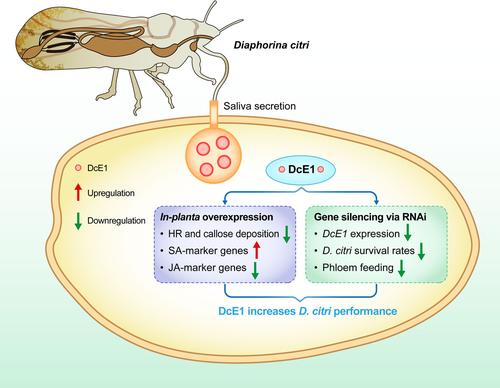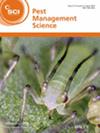求助PDF
{"title":"唾液效应因子 DcE1 可抑制植物防御,并促进亚洲柑橘木虱(Diaphorina citri)成功取食。","authors":"Yinhui Kuang, Chaozhi Shangguan, Chuyang Wang, Liwei Gao, Xiudao Yu","doi":"10.1002/ps.8536","DOIUrl":null,"url":null,"abstract":"<p><strong>Background: </strong>Piercing-sucking insects secrete diverse repertoires of effectors into their hosts to weaken host defenses and promote infestation. The Asian citrus psyllid, Diaphorina citri Kuwayama, is the most destructive insect pest in citrus orchards because of its role as a vector for the huanglongbing pathogen, Candidatus Liberibacter asiaticus (CLas). However, specific effector proteins and their functions in D. citri remain unclear.</p><p><strong>Results: </strong>We demonstrate that DcE1, a salivary protein gene from D. citri, is predominantly expressed in the salivary gland tissues and is delivered into host plants during feeding. Transient expression in tobacco leaves revealed that DcE1 was subcellularly localized in the cytoplasm and plasma membrane, where it inhibited BAX- and INF1-induced cell death, suppressed callose deposition, and activated the salicylic acid pathway by upregulating the expression of endo-β-1,3-glucanase NtBGL2 and regulatory protein NtNPR1. Further, DcE1 knockdown by double-stranded RNA (dsRNA) injection decreased the survival rates of D. citri and interrupted D. citri phloem-feeding on host plants.</p><p><strong>Conclusion: </strong>These results indicate that DcE1 is a novel effector that promotes plant susceptibility and enables D. citri feeding. These findings enhance our understanding of D. citri-plant interactions and offer a potential new target gene for the development of citrus protection strategies. © 2024 Society of Chemical Industry.</p>","PeriodicalId":218,"journal":{"name":"Pest Management Science","volume":" ","pages":""},"PeriodicalIF":3.8000,"publicationDate":"2024-11-14","publicationTypes":"Journal Article","fieldsOfStudy":null,"isOpenAccess":false,"openAccessPdf":"","citationCount":"0","resultStr":"{\"title\":\"Salivary effector DcE1 suppresses plant defense and facilitates the successful feeding of Asian citrus psyllid, Diaphorina citri.\",\"authors\":\"Yinhui Kuang, Chaozhi Shangguan, Chuyang Wang, Liwei Gao, Xiudao Yu\",\"doi\":\"10.1002/ps.8536\",\"DOIUrl\":null,\"url\":null,\"abstract\":\"<p><strong>Background: </strong>Piercing-sucking insects secrete diverse repertoires of effectors into their hosts to weaken host defenses and promote infestation. The Asian citrus psyllid, Diaphorina citri Kuwayama, is the most destructive insect pest in citrus orchards because of its role as a vector for the huanglongbing pathogen, Candidatus Liberibacter asiaticus (CLas). However, specific effector proteins and their functions in D. citri remain unclear.</p><p><strong>Results: </strong>We demonstrate that DcE1, a salivary protein gene from D. citri, is predominantly expressed in the salivary gland tissues and is delivered into host plants during feeding. Transient expression in tobacco leaves revealed that DcE1 was subcellularly localized in the cytoplasm and plasma membrane, where it inhibited BAX- and INF1-induced cell death, suppressed callose deposition, and activated the salicylic acid pathway by upregulating the expression of endo-β-1,3-glucanase NtBGL2 and regulatory protein NtNPR1. Further, DcE1 knockdown by double-stranded RNA (dsRNA) injection decreased the survival rates of D. citri and interrupted D. citri phloem-feeding on host plants.</p><p><strong>Conclusion: </strong>These results indicate that DcE1 is a novel effector that promotes plant susceptibility and enables D. citri feeding. These findings enhance our understanding of D. citri-plant interactions and offer a potential new target gene for the development of citrus protection strategies. © 2024 Society of Chemical Industry.</p>\",\"PeriodicalId\":218,\"journal\":{\"name\":\"Pest Management Science\",\"volume\":\" \",\"pages\":\"\"},\"PeriodicalIF\":3.8000,\"publicationDate\":\"2024-11-14\",\"publicationTypes\":\"Journal Article\",\"fieldsOfStudy\":null,\"isOpenAccess\":false,\"openAccessPdf\":\"\",\"citationCount\":\"0\",\"resultStr\":null,\"platform\":\"Semanticscholar\",\"paperid\":null,\"PeriodicalName\":\"Pest Management Science\",\"FirstCategoryId\":\"97\",\"ListUrlMain\":\"https://doi.org/10.1002/ps.8536\",\"RegionNum\":1,\"RegionCategory\":\"农林科学\",\"ArticlePicture\":[],\"TitleCN\":null,\"AbstractTextCN\":null,\"PMCID\":null,\"EPubDate\":\"\",\"PubModel\":\"\",\"JCR\":\"Q1\",\"JCRName\":\"AGRONOMY\",\"Score\":null,\"Total\":0}","platform":"Semanticscholar","paperid":null,"PeriodicalName":"Pest Management Science","FirstCategoryId":"97","ListUrlMain":"https://doi.org/10.1002/ps.8536","RegionNum":1,"RegionCategory":"农林科学","ArticlePicture":[],"TitleCN":null,"AbstractTextCN":null,"PMCID":null,"EPubDate":"","PubModel":"","JCR":"Q1","JCRName":"AGRONOMY","Score":null,"Total":0}
引用次数: 0
引用
批量引用
Salivary effector DcE1 suppresses plant defense and facilitates the successful feeding of Asian citrus psyllid, Diaphorina citri.
Background: Piercing-sucking insects secrete diverse repertoires of effectors into their hosts to weaken host defenses and promote infestation. The Asian citrus psyllid, Diaphorina citri Kuwayama, is the most destructive insect pest in citrus orchards because of its role as a vector for the huanglongbing pathogen, Candidatus Liberibacter asiaticus (CLas). However, specific effector proteins and their functions in D. citri remain unclear.
Results: We demonstrate that DcE1, a salivary protein gene from D. citri, is predominantly expressed in the salivary gland tissues and is delivered into host plants during feeding. Transient expression in tobacco leaves revealed that DcE1 was subcellularly localized in the cytoplasm and plasma membrane, where it inhibited BAX- and INF1-induced cell death, suppressed callose deposition, and activated the salicylic acid pathway by upregulating the expression of endo-β-1,3-glucanase NtBGL2 and regulatory protein NtNPR1. Further, DcE1 knockdown by double-stranded RNA (dsRNA) injection decreased the survival rates of D. citri and interrupted D. citri phloem-feeding on host plants.
Conclusion: These results indicate that DcE1 is a novel effector that promotes plant susceptibility and enables D. citri feeding. These findings enhance our understanding of D. citri-plant interactions and offer a potential new target gene for the development of citrus protection strategies. © 2024 Society of Chemical Industry.


 求助内容:
求助内容: 应助结果提醒方式:
应助结果提醒方式:


